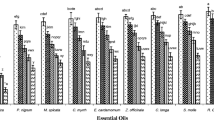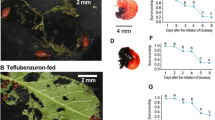Abstract
Midgut epithelial cell culture was successfully developed from red palm weevil (Rhynchophorus ferrugineus) during this study and named as RPW-1. Optimum conditions for four different commercial media were also worked out to successfully maintain the culture. Grace’s medium was found to be the most effective for RPW-1 culturing which resulted in the highest cell density of 7.5 × 106 cells/ml after 72 h of cell seeding with 96% cell viability. It was followed by Schneider’s medium and TNM-FH medium where cell densities reached up to 7.4 × 106 and 5.9 × 106 cells/ml, respectively, after 72 h having 91 and 89% cell viability. Comparatively, Media-199 was least effective for RPW-1 cell culturing. As a whole, temperature at 27°C and pH 6.3 were the best for RPW-1 culturing where the highest cell density and maximum cell viability were noted. Individually, Grace’s medium, Schneider’s medium, TNM-FH medium, and Media-199 produced better results at 27°C, 27°C, 24°C, and 21°C and pH 6.3, 6.4, 5.3, and 7.1, respectively. The toxicity assay and MTT cell proliferation assay revealed that, out of the ten insecticides used in this study, emamectin benzoate was the most toxic insecticide to RPW-1 cells resulting in 92% cell mortality and 74% cell growth inhibition. Dieldrin was the least potent, causing only 19% cell mortality and 18% cell growth inhibition.





Similar content being viewed by others
References
Al-Ayedh H. Y. Evaluating a semi-synthetic diet for rearing the red palm weevil Rynchophorus ferrugineus (Coleoptera: Curculionidae). Int. J. Trop. Insect. Sci. 31: 20–28; 2011.
Alford D. V. Pest and disease management handbook. British crop protection enterprises. Blackwell Science Ltd, Oxford, p 615; 2000.
Casartelli M.; Cermenati G.; Rodighiero S.; Pennacchio F.; Giordana B. A megalin like receptor is involved in protein endocytosis in the midgut of an insect (Bombyx mori, Lepidoptera). Am. J. Physiol. 295: 1290–1300; 2008.
Cermenati G.; Corti P.; Caccia S.; Giordana B.; Casartelli M. A morphological and functional characterization of Bombyx mori larval midgut cells in culture. Invert. Surv. J. 4: 119–126; 2007.
Corley L. S.; Lavine M. D. A review of insec stem cell types. Semin. Cell. Dev. Biol. 17: 510–517; 2006.
Decombel L.; Smagghe G.; Tirry L. Action of major insecticide groups on insect cell lines of the beet armyworm, Spodoptera exigua, compared with larvicidal toxicity. In. Vitro. Cell. Dev. Biol. -Animal. 40: 43–51; 2004.
Faleiro J. R. A review of the issues and management of the red palm weevil Rhynchophorus ferrugineus (Coleoptera: Rhynchophoridae) in coconut and date palm during the last one hundred years. Int. J. Trop. Insect. Sci. 26: 135–154; 2006.
Grasela J. J.; McIntosh A. H.; Ringbauer J. J.; Goodman C. L.; Carpenter J. E.; Popham H. J. Development of cell lines from the cactophagous insect: Cactoblastis cactorum (Lepidoptera: Pyralidae) and their susceptibility to three baculoviruses. In. Vitro. Cell Dev. Biol. - Animal. 48: 293–300; 2012.
Grimm C.; Schmidli H.; Bakker F.; Brown K.; Campbell P.; Candol W. M.; Chapman P.; Harrison E. G.; Mead-Briggs M.; Schmuck R.; Ufer A. Use of standard toxicity tests with Typhlodromus pyri and Aphidius rhopalosiphi to establish a dose–response relationship. J. Pest. Sci. 74: 72–84; 2001.
Hakim R. S.; Baldwin K. M.; Loeb M. The role of stem cells in midgut growth and regeneration. In. Vitro. Cell Dev. Biol. - Animal. 37: 338–42; 2001.
Hakim R. S.; Blackburn M. B.; Corti P.; Gelman D. B.; Goodman C.; Elsen K.; Loeb M. J.; Lynn D.; Soin T.; Smagghe G. Growth and mitogenic effects of arylphorin in vivo and in vitro. Arch. Insect. Biochem. Physiol. 64: 63–73; 2007.
Hakim R. S.; Cacci S.; Loeb M.; Smagghe G. Primary culture of insect midgut cells. In. Vitro. Cell Dev. Biol. - Animal. 45: 106–110; 2009.
Hall G. M.; Tittiger C.; Andrews G. L.; Mastick G. S.; Kuenzli M.; Luo X.; Seybold S. J.; Blomquist G. J. Midgut tissue of male pine engraver lps pini, synthesizes mono terpenoid pheromone component ipsdienol de novo. Naturwissenschaflen. 89: 79–83; 2002a.
Hall G. M.; Tittiger C.; Btomquist G. J.; Andrews G. B.; Mastick G. S.; Barkawi L. S.; Bengoa C.; Seybold S. J. Male Jeffrey pine beetle, Dendroctonus jeffreyi, synthesizes the pheromone component frontalin in anterior midgut tissue. Insect. Biochem. Mol. Biol. 32: 1525–1532; 2002b.
Hild H. M.; Emery A. N.; AL-Rubeat M. The effect of pH, temperature, serum concentration and media composition on the growth of insect cells. In: Vlak J. M.; Schlaeger E. J.; Bernard A. R. (eds) Baculovirus and recombinant protein production processes. Editiones Roche, Basel, pp 316–321; 1992.
Hink W. F. Semi-continuous culture of the TN-368 cell line in fermenters with virus production in harvested cells. In: Kurstak E.; Maramorosch K.; Dubendrofer A. (eds) Invertebrate System In Vitro. Elsevier, Holland, pp 27–33; 1982.
Huang J. F.; Shui K. J.; Li H. Y.; Hu M. Y.; Zhong G. H. Antiproliferative effect of azadirachtin A on Spodoptera litura Sl-1 cell line through cell cycle arrest and apoptosis induced by up-regulation of p53. Pestic. Biochem. Physiol. 99: 16–24; 2011a.
Huang J. F.; Tian M.; Lv C. J.; Li H. Y.; Muhammad R.; Zhong G. H. Preliminary studies on induction of apoptosis by abamectin in Spodoptera frugiperda (Sf9) cell line. Pestic. Biochem. Physiol. 100: 256–263; 2011b.
Kurtti T. J.; Munderloh U. G. Mosquito cell culture. In: Maramorosch K. (ed) Advances in cell culture, vol. 3. Academic, New York, p 259; 1984.
Li L.; Xie T. Stem cell niche: structure and function. Annu. Rev. Cell. Dev. Biol. 21: 605–31; 2005.
Loeb M. J.; Clark E. A.; Blackburn M.; Hakim R. Z.; Elsen K.; Smagghe G. Stem cells from midgets of lepidopteran larvae: clues to the regulation of stem cell fate. Arch. Insect. Biochem. Physiol. 53: 186–98; 2003.
Lynn D. E. Novel techniques to establish new insect cell lines. In. Vitro. Cell. Dev. Biol. -Animal. 37: 319–321; 2001.
Mahmoud M. A.; Saad A. A.; Ibrahim A. B. In vivo toxicity of Beta-cyfluthrin insecticide against the red palm weevil Rhynchophorus ferrugineus (Olivier). J. Agr. Sci. Tech. A. 2: 1322–1331; 2012.
Nandi A.; Chandi D.; Lechesa R.; Pryor S. C.; Mclaughlin A.; Bonventre J. A.; Flynn K.; Weeks B. S. Bifenthrin causes neurite retraction in the absence of cell death: a model for pesticide associated neurodegeneration. Med. Sci. Monit. 12: 169–173; 2006.
Nardi J. B.; Young A. G.; Ujhelyi E.; Tittiger C.; Lehane M. J.; Blomquist G. J. Specialization of midgut cells for synthesis of male isoprenoid pheromone components in two scolytid beetles, Dendroctonus jeffreyi and Ips pini. Tissue. Cell. 34: 221–231; 2002.
Oh H.; Livingston R.; Smith K.; Abrishamian G. L. Comparative study of the time dependency of cell death assays. M.U.R.J. 11: 53–62; 2004.
Saito S.; Sakamoto N.; Umeda K. Effects of pyridalyl, a novel insecticidal agent, on cultured Sf9 cells. J. Pestic. Sci. 30: 17–21; 2005.
SAS. SAS user’s guide: statistics. SAS Institute, Cary; 2000.
Shao H. C.; Hong L. S.; Zuo H. L. Effect of temperature oscillation on insect cell growth and baculovirus replication. Appl. Environ. Microbiol. 64: 2237–2239; 1998.
Smagghe G.; Goodman C. L.; Stanley D. Insect cell culture and applications to research and pest management. In. Vitro. Cell Dev. Biol. - Animal. 45: 93–105; 2009.
Smagghe G.; Vanhassel W.; Moeremans C.; de Wilde D.; Goto S.; Loeb M. J.; Blackburn M. B.; Hakim R. S. Stimulation of midgut stem cell proliferation and differentiation by insect hormones and peptides. Ann. NY. Acad. Sci. 1040: 472–475; 2005.
Sohi S. S. The effect of pH and osmotic pressure on the growth and survival of three lepidopteran cell lines. In: Kurstak E.; Maramorosch K.; Dubendorfer A. (eds) Invertebrate systems in vitro. Elsevier, North Holland, pp 35–43; 1980.
Sonoda S.; Tsumuki H. Induction of heat shock protein genes by chlorfenapyr in cultured cells of the cabbage armyworm, Mamestra brassicae. Pestic. Biochem. Physiol. 89: 185–189; 2007.
Ware G. W.; Nigg H. N.; Doerge D. R. Reviews of environmental contamination and toxicology, vol. 176. Springer, New York, p 184; 2003.
Yoon J. Y.; Oh S. H.; Yoo S. M.; Lee S. J.; Lee H. S.; Choi S. J.; Moon C. K.; Lee B. H. N-Nitrosocarbofuran, but carbofuran, induces apoptosis and cell cycle arrest in CHL cells. Toxicology. 169: 153–161; 2001.
Young H. E.; Black Jr. A. C. Adult stem cells. Anat. Rec. A. Discov. Mol. Cell. Evol. Biol. 276: 75–102; 2004.
Zhong G. H.; Shui K. J.; Huang J. F.; Jia J. W.; Hu M. Y. Induction of apoptosis by botanical components in Spodoptera litura cultured cell line. Acta. Entomol. Sin. 51: 449–453; 2008.
Acknowledgments
The authors gratefully acknowledge the role of King Abdul Aziz City of Science and Technology (KACST) for providing research funding under the grant no. 08-BIO 10-6 to conduct this study.
Author information
Authors and Affiliations
Corresponding author
Additional information
Editor: T. Okamoto
Ahmed Mohammed Aljabr and Muhammad Rizwan-ul-Haq equally participated in the research work.
Rights and permissions
About this article
Cite this article
Aljabr, A.M., Rizwan-ul-Haq, M., Hussain, A. et al. Establishing midgut cell culture from Rhynchophorus ferrugineus (Olivier) and toxicity assessment against ten different insecticides. In Vitro Cell.Dev.Biol.-Animal 50, 296–303 (2014). https://doi.org/10.1007/s11626-013-9694-1
Received:
Accepted:
Published:
Issue Date:
DOI: https://doi.org/10.1007/s11626-013-9694-1




